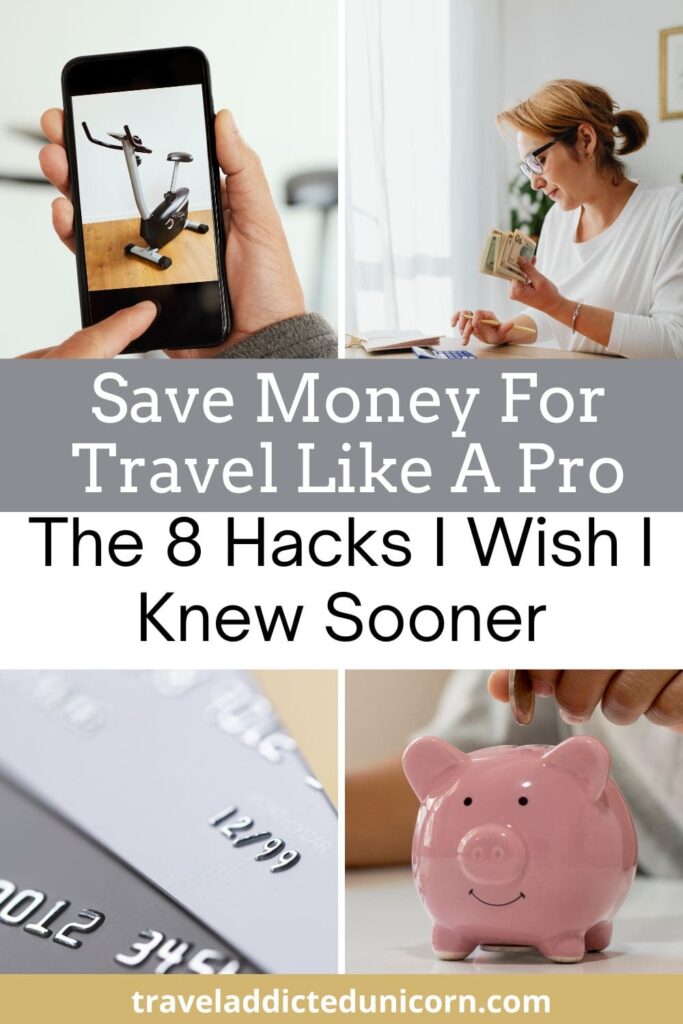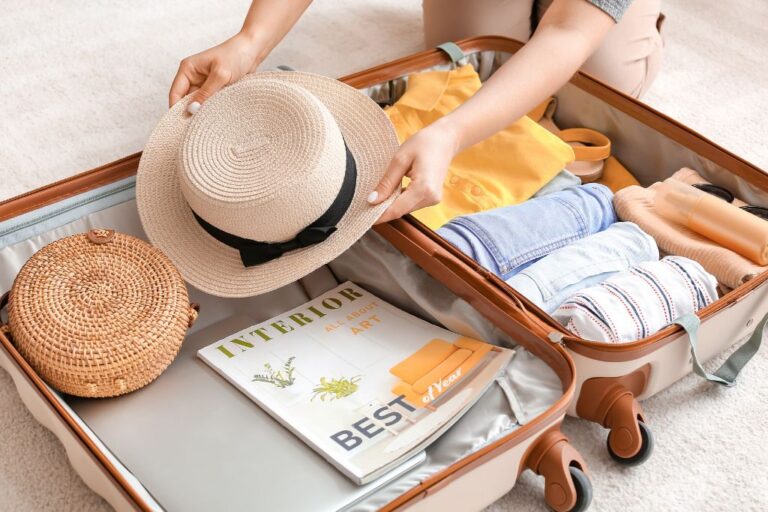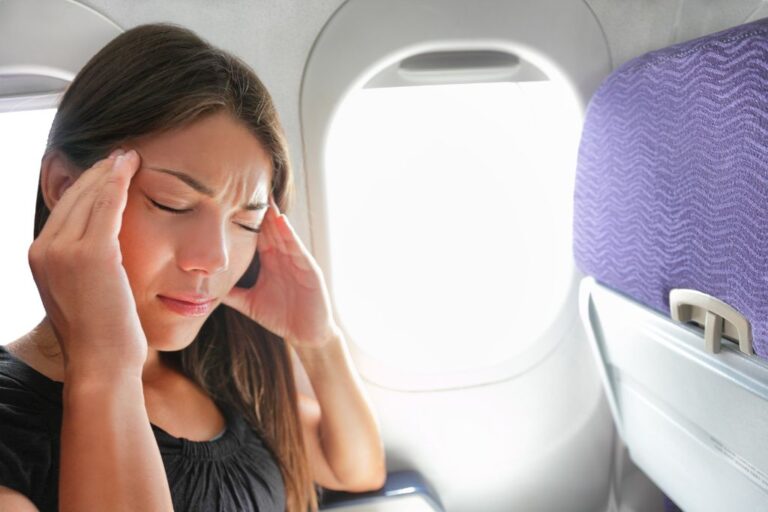Save Money For Travel Like A Pro: The 8 Hacks I Wish I Knew Sooner
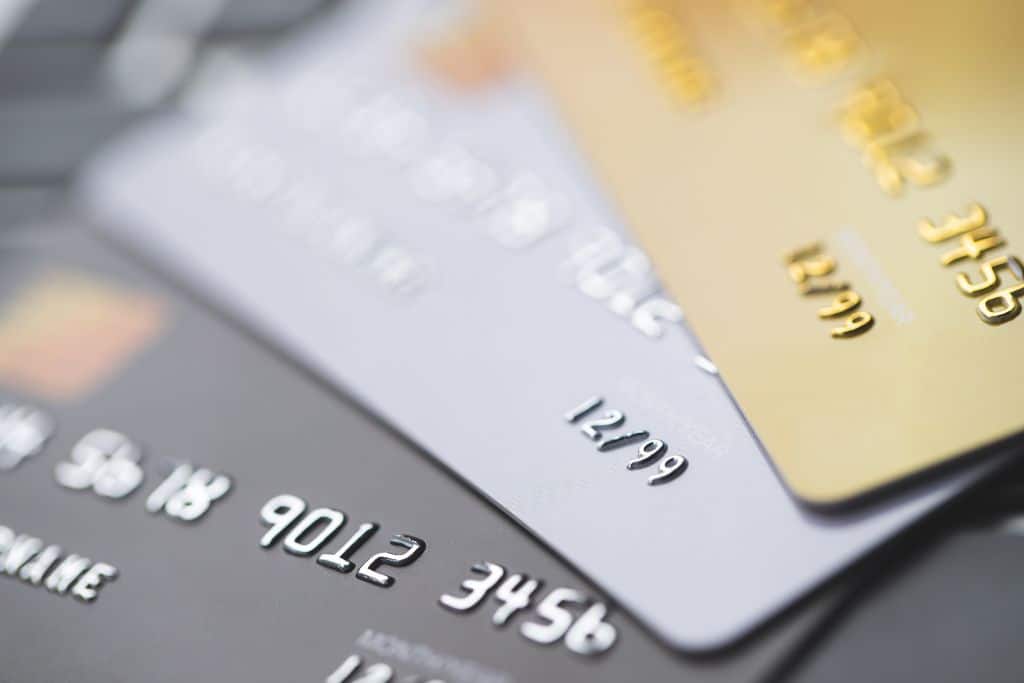
Want To Travel Like A Pro But Not Sure How You Can Afford It? Keep Reading To Find Out!
So, how do I save money for travel, then?
Dreaming of sipping espresso in a Parisian café or hiking the Inca Trail, but your bank account says otherwise? I’ve been there.
For the longest time, I thought travel was something only wealthy people or hardcore budgeters could afford.
But after years of trial and error (and a few financial flops), I finally figured out how to make travel a reality without draining my savings.
In this post, I’m sharing the 8 practical hacks that completely changed the game for me.
Whether you’re planning a weekend getaway or your dream international adventure, these tips will get you one step closer to takeoff.
1. Create A Separate “Travel Fund” Account
Having a separate bank account just for travel is a game-changer.
When your travel savings are mixed in with your regular checking or emergency fund, it’s easy to “accidentally” spend them.
By isolating your travel money, you create a mental (and physical) boundary that makes saving more intentional.
Look for a high-yield savings account. Many online banks offer better interest rates than traditional ones, helping your money grow passively.
In addition, set up automatic transfers that are aligned with your pay schedule.
For example, if you get paid bi-weekly, schedule a $25 transfer into your travel fund every payday. That’s $650 a year without any extra effort.
Also, you can use visual motivators. Rename the account something exciting like “Thailand Trip 2026” or “Iceland Adventure Fund.”
Seeing your progress in a separate account not only builds excitement but also keeps you focused on the goal.
Some people even go old school with a cash/change jar or piggy bank at home labeled with their dream destination.
You won’t miss the small change, and the money will eventually add up and you can use it to buy a day trip or book a hotel.
Also, it is kind of rewarding to watch your travel jar grow with money as you can see yourself closer to your dream destination.
Find a picture of your dream destination and glue it on your travel jar to inspire you to constantly donate to the mission.

2. Use Cashback And Rewards Programs
Why not let your regular spending work for you?
Cashback and travel reward programs can significantly boost your travel savings with minimal effort.
Start by signing up for cashback apps like Rakuten, TopCashback, or Honey, which give you a percentage back on online purchases.
Simply click through their site or install their browser extension before you shop, and the savings are automatic.
For bigger benefits, consider a travel rewards credit card.
Depending on which country you are in, you can get a different credit card that offers points or miles for every dollar you spend.
Use these cards for groceries, gas, and bills, but only if you can pay the balance off in full each month to avoid interest.
You can even use a cashback site in combination with a rewards card for extra savings.
Let’s say you book a hotel through Rakuten and pay with a points-earning card. You’ll get cashback from Rakuten and travel points from your card.
Just remember to track your points and cashback earnings in a spreadsheet or app so you don’t forget to redeem them!

3. Cancel Subscriptions You Don’t Use
Subscriptions can quickly add up and become a hidden drain on your finances.
Take 15 minutes to review your monthly subscriptions, including streaming services like Netflix, Hulu, and Spotify.
As well as subscription boxes, apps, gym memberships, and even software tools.
It’s easy to forget about those recurring charges, but even a few $10–$20 subscriptions can add up to hundreds of dollars annually.
The first step is to make a list of everything you’re subscribed to, then assess whether you’re truly using each service.
If not, cancel it. For example, if you haven’t touched your fitness app in months, consider freezing or cancelling it until you’re ready to commit again.
Do you still have that landline? Nope, I didn’t think so. Cancel it!
Consider using a subscription management app like Rocket Money or Trim to automatically track and cancel unwanted subscriptions.
If you’re unsure about cancelling something, many companies offer pause options.
You can freeze your subscription for a few months and pick it back up later, saving money in the meantime.
If you can’t cancel certain services (like Internet), then see if you can lower the amount you have to pay. Call your provider and ask if you can get a cheaper deal.
Shop around for cheaper car insurance (any type of insurance, really), Internet provider, cell phone provider, etc.
You will be surprised at how much you can save by bargaining with companies, as they do not want to lose your business.
Also, review your credit cards – cancel ones that charge you an Annual Fee or have high-interest rates.
And sign up for ones that give you cashback or some sort of points.

4. Build Better Money Habits
When you are trying to save money for travel, building better money habits is often more powerful than cutting corners.
Start with the 30-day rule: if you want to buy something non-essential, wait 30 days—chances are you’ll realize you don’t really need it.
During those 30 days, you might come up with alternative solutions, like borrowing, renting, or finding a more affordable version of the item.
Pair that with a no-spend challenge, where for a set period (like a week or month), you commit to spending only on essentials.
Many people find that after completing a no-spend challenge, they continue to spend less overall, shifting their mindset toward more mindful spending.
If you find it difficult to resist temptation, consider giving yourself a small reward at the end of the challenge, like a nice Starbucks coffee, for example.
For passive savings, use round-up apps like Acorns, which automatically round up your purchases and deposit the change into savings.
With $0.25 here, $0.75 there, and suddenly you’ve got enough for a weekend getaway.
Over time, these small amounts add up without you having to change your spending habits.
It’s like having a tiny, painless automatic savings plan that works for you 24/7.
To stay on track, a budgeting app like YNAB or Mint can help you spot impulse buys before they happen.
By using these apps, you can easily set a specific budget for non-essential items, making it easier to say no when temptation strikes.
Plus, many of these apps categorize your spending, so you can see exactly how much you’re spending.
You can track things like entertainment, dining out, and shopping, which are often the areas that sabotage your savings goals.

5. Sell Unused Items Around The House
We all have unused items lying around our homes—old clothes, books, electronics, furniture, and more.
Instead of letting them collect dust, sell them to boost your travel savings.
You can use platforms like Facebook Marketplace, Poshmark, eBay, or Depop to sell clothes, accessories, and electronics.
Alternatively, use apps like Craigslist and OfferUp for larger items like furniture and appliances.
Start by going through your closet, drawers, and storage spaces, and gather everything you no longer use or need.
It’s a quick way to declutter while earning extra cash for your next trip. The best part?
Many of these items are likely just sitting there, not bringing any value to your life or savings.
Turn them into travel funds by simply listing them for sale.
To maximize profits, take clear, attractive photos of the items, and provide detailed descriptions.
You’d be amazed how much people are willing to pay for gently used items, especially electronics or branded clothes.
The extra money from these sales can be a great start to your travel fund, and you’ll also enjoy a tidier space.
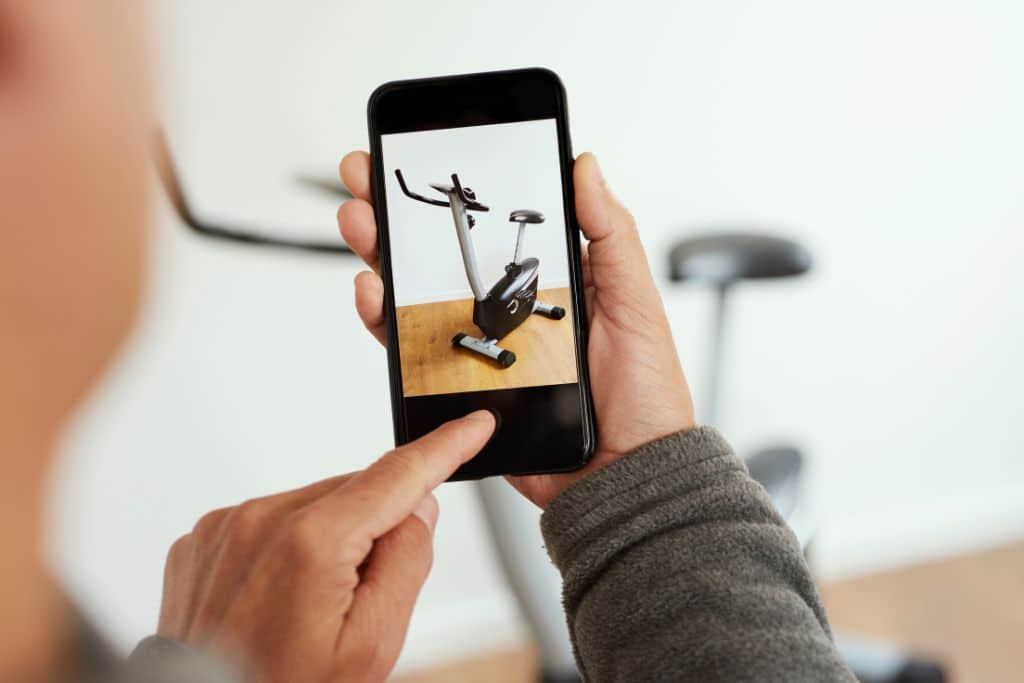
6. Cook More, Dine Out Less
Eating out can be one of the biggest drains on your budget, especially if you love trying new restaurants.
By cooking more at home, you’ll save money that can go straight into your travel fund.
Instead of grabbing takeout every few days, try meal prepping at the start of the week, so you have lunch and dinner ready to go.
Meal planning can help too. Plan your meals around sales or discounts at your local grocery store, and stick to a shopping list to avoid impulse buys.
You don’t have to go all-out with fancy recipes—simple, nutritious meals can be made on a budget.
For those days when cooking feels like too much, look into freezer meals.
Prepare larger batches of food that you can freeze and heat up when you’re tired.
Also, bringing your lunch to work is a huge saver of money even if you do it only a few days a week.
Spend Sundays browsing flyers for deals on groceries (either paper ones or online), buy the groceries, chop, and prep them for the upcoming week.
To make it less tedious, listen to some music, a podcast, or an audiobook while you are prepping the food. If you don’t like chopping, there are lots of small appliances that can chop for you.
Also, think about making your coffee/tea at home or using the free one at work. Even though coffee doesn’t cost a lot, it surely adds up in the end.
If that is not possible, then treat yourself to coffee once in a while, but don’t buy it every day.
If you love coffee, invest in a nice coffee maker and fill up a thermos so you can take it with you to work.
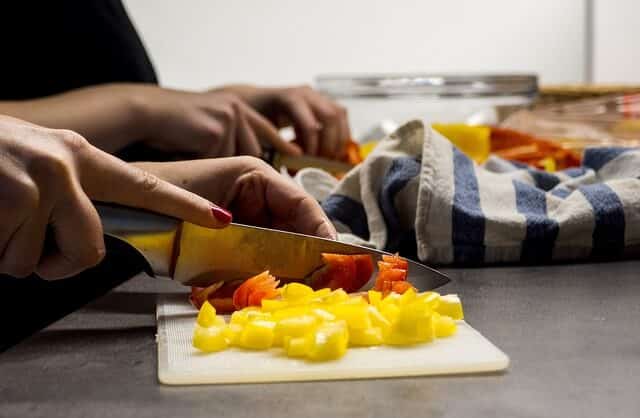
7. Spend More Nights In/Free Activities
One of the smartest ways to save more money for travel, while still enjoying life, is to spend more nights in and seek out free or low-cost activities where you live.
Instead of hitting bars, restaurants, or expensive entertainment venues every weekend, try hosting potluck dinners with friends, organizing themed movie or game nights, or simply enjoying a quiet evening reading or journaling.
You’d be surprised how quickly those $40–$60 nights out add up over a month or two.
Also, many cities offer a surprising number of free local events.
Look out for things like summer movie nights in the park, free museum admission days, community art shows, yoga in the park, or seasonal street festivals.
Public libraries often host free talks, author events, and workshops that can be surprisingly enriching.
In addition, explore local parks and hiking trails, visit open-air markets, wander through historic neighborhoods, or attend cultural festivals or outdoor music performances.
Some major cities even offer city-specific discount cards or apps that highlight free or “pay what you can” attractions.
Also, you can play sports outside – tennis, soccer, baseball, etc.
Most places have community teams you can join (also keeps you active and in shape). Or how about biking, jogging, or rollerblading? Invite friends to go with you if possible.
If you decide to go out, search the Internet for discounts or coupons.
Check sites like Groupon (or the equivalent in your country) for cheaper tickets on events/entertainment.

8. Pamper Yourself At Home
If you love indulging in self-care rituals like massages, spa days, or salon visits, but you’re also trying to build up your travel fund, one of the most effective strategies is to pamper yourself at home.
Instead of booking a $150 massage or splurging on a $60 manicure every few weeks, create your own relaxing sanctuary right in your living room or bathroom.
Set the mood with calming music, candles, and dim lighting, and treat yourself to a warm bubble bath.
Also, a DIY facial using affordable skincare products, or a homemade hair treatment with ingredients from your kitchen, like coconut oil and honey.
You can give yourself a manicure or pedicure while sipping tea or wine and catching up on your favorite show.
Learn how to dye your own hair or ask a friend to do it for you, and go to the hair salon once a year to get a haircut.
These cozy, intentional moments of self-care not only help you recharge but also save you hundreds over time.
To stay motivated, track how much each at-home spa night is saving you and transfer that amount into a designated travel savings account.
For example, skipping a monthly massage could save you $1,200 a year. That is enough for a round-trip flight to Europe or a week at a tropical resort.
That is not to say you can’t pamper yourself, but to limit the visits, find cheaper salons, and do the most you can by yourself at home.
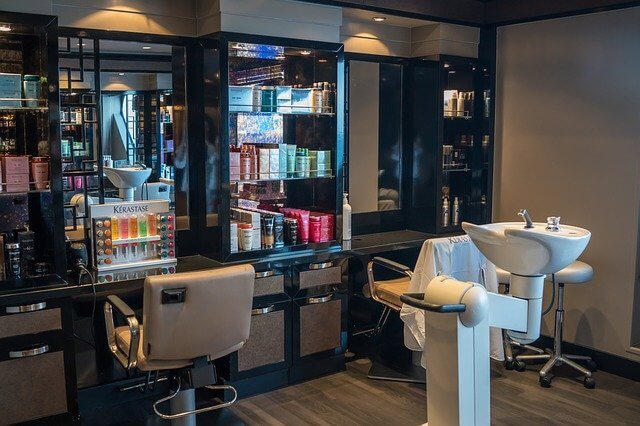
The 8 Hacks to Save Money For Travel Like A Pro
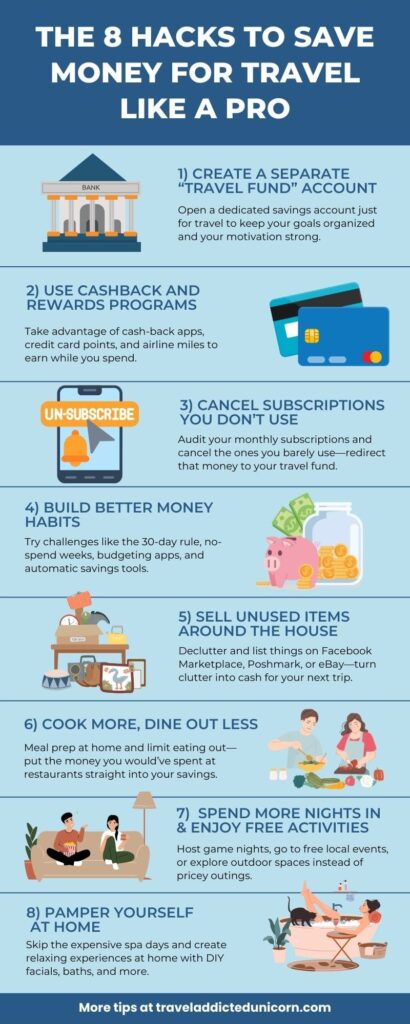
🦄 Related Budget Blog Posts:
30+ Travel Essentials To Buy At The Dollar Store
Want To Travel More For Less? These 8 Booking Tips Make It Possible
Conclusion: Save Money For Travel Like A Pro: The 8 Hacks I Wish I Knew Sooner
Saving money for travel doesn’t have to mean living on the bare minimum.
It’s about making intentional choices that align with your bigger goals.
Whether you’re rounding up spare change, cutting back on impulse buys, or swapping nights out for cozy evenings in, every small shift brings you closer to boarding that plane or hitting the road.
These strategies aren’t just about budgeting, they’re about building a lifestyle that supports your dreams.
Travel is one of the most enriching things you can invest in.
With the right mindset and a few smart habits, it’s absolutely within reach.
